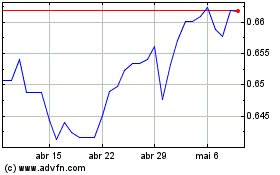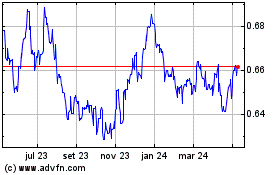Commodity Currencies Slide Amid Risk Aversion
27 Março 2024 - 12:00AM
RTTF2
The commodity currencies such as Australia, the New Zealand and
the Canadian dollars weakened against their major currencies in the
Asian session on Wednesday amid risk aversion, as traders continued
to be cautious and look ahead to key U.S. and European inflation
readings later in the week and comments from central bank officials
for additional clues on the interest rate outlook.
Traders also were concerned about the economic impact of the
indefinite suspension of vessel traffic into and out of the Port of
Baltimore. Vessel traffic was suspended after a cargo ship crashed
into a pillar of the Francis Scott Key Bridge early Tuesday
morning, leading to the bridge's collapse.
The Australian dollar started falling against its major rivals,
after the release domestic inflation data that beat market
expectations, and the reading is the lowest since November
2021.
Data from the Australian Bureau of Statistics showed that the
monthly consumer price index rose by 3.4 percent annually in
February, the same as in previous month but slightly below
economists' forecast of 3.5 percent.
Trading volumes are likely to remain thin as investors brace for
the Easter weekend.
Oil extended overnight losses as the API report showed a large
build in U.S. inventories. Crude oil prices settled lower with
traders assessing oil demand and supply positions amid the tensions
in the Middle East. West Texas Intermediate Crude oil futures for
May ended lower by $0.33 at $81.62 a barrel.
In the Asian trading today, the Australian dollar fell to a
5-day low of 1.6622 against the euro, from yesterday's closing
value of 1.6567. The aussie may test support near the 1.67
region.
Against the U.S. dollar and the yen, the aussie slipped to 2-day
lows of 0.6511 and 98.74 from Tuesday's closing quotes of 0.6538
and 99.00, respectively. If the aussie extends its downtrend, it is
likely to findc support around 0.64 against the greenback and 97.00
against the yen.
Against the Canada and the New Zealand dollars, the aussie slid
to 5-day lows of 0.8854 and 1.0868 from yesterday's closing quotes
of 0.8880 and 1.0884, respectively. On the downside, 0.87 against
the loonie and 1.07 against the kiwi are seen as the next support
level for the aussie.
The NZ dollar fell to more than a 4-month low of 1.8078 against
the euro and a 2-day low of 0.5988 against the U.S. dollar, from
Tuesday's closing quotes of 1.8032 and 0.6007, respectively. If the
kiwi extends its downtrend, it is likely to find support around
1.82 against the euro and 0.58 against the greenback.
Against the yen, the kiwi edged down to 90.79 from yesterday's
closing value of 90.96. The kiwi is likely to find support around
the 89.00 region.
The Canadian dollar fell to a 2-day low of 1.3599 against the
U.S. dollar, from yesterday's closing value of 1.3582. The loonie
is likely to find support around the 1.36 region.
Against the euro and the yen, the loonie dropped to 1.4723 and
111.41 from Tuesday's closing quotes of 1.4711 and 111.51,
respectively. If the loonie extends its downtrend, it is likely to
find support around 1.48 against the euro and 110.00 against the
yen.
Meanwhile, the U.S. dollar rose against its major rivals in the
Asian session amid risk aversion.
The U.S. dollar appreciated to a 34-year high of 151.97 against
the yen, from Tuesday's closing value of 151.52. The greenback may
test resistance near the 153.00 region.
Against the euro and the pound, the greenback rose to 2-day
highs of 1.0820 and 1.2609 from yesterday's closing quotes of
1.0833 and 1.2628, respectively. If the greenback extends its
uptrend, it is likely to find resistance around 1.07 against the
euro and 1.25 against the pound.
The greenback edged up to 0.9403 against the Swiss franc, from
an early low of 0.9033. On the upside, 0.91 is seen as the next
resistance level for the greenback.
Looking ahead, the European Commission is set to release euro
area economic sentiment survey results for March at 6:00 am ET in
the European session on Wednesday.
In the New York session, U.S. MBA mortgage approvals data and
U.S. EIA crude oil data are slated for release.
AUD vs US Dollar (FX:AUDUSD)
Gráfico Histórico de Câmbio
De Mar 2024 até Abr 2024

AUD vs US Dollar (FX:AUDUSD)
Gráfico Histórico de Câmbio
De Abr 2023 até Abr 2024
